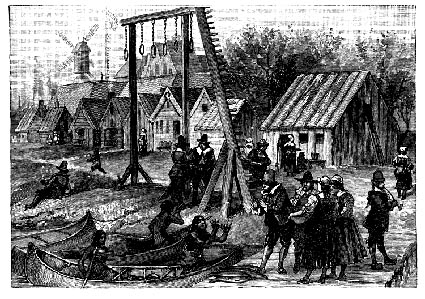|
First Women Executed in NH |
|
Page 4 of 5
A WARNING TO ALL OTHERS (continued)

The Day of Execution
Accompanied by the ministers of Portsmouth, Sarah Simpson and Penelope Kenny were then led about a mile to the place of execution, a gallows erected in a field between the homes of William Cotton and Edward Cates in 1718. (32) Although a fresh blanket of snow had shrouded the landscape the day before, “the execution of the said women drew together a vast concourse of people” and the “numerous spectators seem’d earnestly concern’d for them.” (33) In the crowd was Samuel Lane, a young cordwainer who traveled from Hampton to see “two women Hanged at the Bank.” (34) But Lane’s terse entry does not reveal how he felt as he watched Sarah Simpson and Penelope Kenny climb the gallows and utter their final statements before Sherriff Eleazar Russell carried out his grisly task. (35)
Simpson handed one of the ministers “a Writing…said to be of her dictating” that was “publickly read at her desire.” She confessed “in a very moving manner,” that she “pass’d away her early days in light and wicked Company” and mentioned “with regret, that when she entered into the Marriage State, it was not with one that took care to maintain the exercise of Family Religion,” and advised her listeners “that when they marry, to make it their great Care to marry in the Lord.” (36) When given her chance, Penelope Kenny also spoke “ a few words by the way of Warning to others, and the Rev. Mr. Fitch having then commended them both to the Mercy of God in Christ, she and the other were executed…and left us not without hopes of their being delivered from the second Death.”(37)
Shrouded in Mystery
But even after the executions faded into memory, a couple of mysteries refused to die. If Sarah Simpson buried her infant and Penelope Kenny cast hers into the churning waters of the Piscataqua River, who was the mother of the dead baby found in the well in August 1739?
A surprising archaeological discovery made during the 1970s revealed that women in other regions of colonial America practiced this manner of disposing unwanted offspring. (38) In Portsmouth, William Shurtleff was convinced “that there has been one among us…that is equally & it may be more heinously guilty in the sight of God…and could I suppose the Person to be within Hearing, I would say…Be assur’d that though you are as yet concealed from Men, both you and your Crime are known to God.” (39)
But the identity of that third guilty person, who may also have been a servant in Portsmouth, was apparently never discovered. And who were the fathers of Sarah Simpson’s and Penelope Kenny’s illegitimate children? A 1702 law dictated, “he that is accused by any woman to be the father of a Bastard Child begotten of her body, she continuing constant in her accusation being exam’d upon Oath…he shall be adjudged the reputed father of such child notwithstanding his denial and stand charged with the maintenance thereof.” (40) But there is nothing to indicate that the two women attempted this legal recourse. It seems that Sarah Simpson and Penelope Kenny took these secrets with them to their unmarked graves. (41)
A Warning to All Others
What is clear, however, is that the events of 1739 made a profound impression on all who witnessed them. Jabez Fitch was confident that “the sad end of these women may be a Warning to all others, to take heed of the Sin of Uncleanness,” echoing sentiments expressed by Cotton Mather more than forty years earlier. (42) William Shurtleff fervently hoped that, “nothing of the like Nature might again happen among us!”
But the events of 1739 ushered in a new era of crime and punishment in New Hampshire. Four more individuals were executed there during the eighteenth-century, including Ruth Blay, who was infamously hanged in Portsmouth for infanticide on December 30, 1768, nearly twenty-nine years to the day that Sarah Simpson and Penelope Kenny met their demise at the end of a rope. (43) But there is evidence that after the American Revolution, prevailing attitudes towards bastardy and infanticide had begun to shift in New England. (44) In the early 1790s, the 1714 statute that brought about the first executions in New Hampshire’s history was repealed, replaced by a form of “symbolic” execution in which “the Mother so offending” could “be set on the Gallows for the space of one hour,” forced to suffer public humiliation but not death. (45)
Copyright © 2006 by Christopher Benedetto
Reprinted by permission of the New England Historic Genealogical Society. Christopher Benedetto, "'A Warning to All Others': The Story of the First Executions in New Hampshire's History." New England Ancestors vol. 6, no. 5-6 (Holiday 2005): 24-27, 55. For more information about New England Ancestors magazine and the New England Historic Genealogical Society, please visit their web site here.
CONTINUE with A WARNING TO ALL OTHERS
Please visit these SeacoastNH.com ad partners.



 Smuttynose Murders
Smuttynose Murders



















